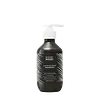What's inside
What's inside
 Key Ingredients
Key Ingredients

No key ingredients
 Benefits
Benefits

 Concerns
Concerns

 Ingredients Side-by-side
Ingredients Side-by-side

Aloe Barbadensis Leaf Juice
Skin ConditioningSodium Methyl Cocoyl Taurate
CleansingCocamidopropyl Betaine
CleansingDecyl Glucoside
CleansingCoco-Glucoside
CleansingGlyceryl Oleate
EmollientPropanediol
SolventPiroctone Olamine
PreservativeMentha Piperita Oil
MaskingHydrolyzed Quinoa
Skin ConditioningPolyquaternium-10
Potassium Sorbate
PreservativeOlea Europaea Fruit Oil
MaskingHippophae Rhamnoides Fruit Oil
Skin ProtectingHydrolyzed Jojoba Esters
Skin ConditioningLinum Usitatissimum Seed Oil
PerfumingSqualane
EmollientHelianthus Annuus Seed Oil
EmollientHibiscus Sabdariffa Flower Extract
Skin ConditioningCamellia Sinensis Extract
AntioxidantBertholletia Excelsa Seed Oil
EmollientMacadamia Ternifolia Seed Oil
EmollientRosmarinus Officinalis Leaf Extract
AntimicrobialPentylene Glycol
Skin ConditioningCaprylyl Glycol
EmollientEthylhexylglycerin
Skin ConditioningCitric Acid
BufferingAloe Barbadensis Leaf Juice, Sodium Methyl Cocoyl Taurate, Cocamidopropyl Betaine, Decyl Glucoside, Coco-Glucoside, Glyceryl Oleate, Propanediol, Piroctone Olamine, Mentha Piperita Oil, Hydrolyzed Quinoa, Polyquaternium-10, Potassium Sorbate, Olea Europaea Fruit Oil, Hippophae Rhamnoides Fruit Oil, Hydrolyzed Jojoba Esters, Linum Usitatissimum Seed Oil, Squalane, Helianthus Annuus Seed Oil, Hibiscus Sabdariffa Flower Extract, Camellia Sinensis Extract, Bertholletia Excelsa Seed Oil, Macadamia Ternifolia Seed Oil, Rosmarinus Officinalis Leaf Extract, Pentylene Glycol, Caprylyl Glycol, Ethylhexylglycerin, Citric Acid
Water
Skin ConditioningSodium Cocoyl Isethionate
CleansingLauramidopropyl Betaine
CleansingCocamidopropyl Betaine
CleansingSodium Lauroyl Sarcosinate
CleansingParfum
MaskingAloe Barbadensis Leaf Juice
Skin ConditioningEucalyptus Globulus Leaf Extract
PerfumingHistidine
HumectantMentha Piperita Oil
MaskingMentha Arvensis Leaf Oil
MaskingSodium Benzoate
MaskingSodium Salicylate
PreservativeMenthol
MaskingPolyquaternium-10
Sodium Citrate
BufferingCitric Acid
BufferingTetrasodium EDTA
Water, Sodium Cocoyl Isethionate, Lauramidopropyl Betaine, Cocamidopropyl Betaine, Sodium Lauroyl Sarcosinate, Parfum, Aloe Barbadensis Leaf Juice, Eucalyptus Globulus Leaf Extract, Histidine, Mentha Piperita Oil, Mentha Arvensis Leaf Oil, Sodium Benzoate, Sodium Salicylate, Menthol, Polyquaternium-10, Sodium Citrate, Citric Acid, Tetrasodium EDTA
Ingredients Explained
These ingredients are found in both products.
Ingredients higher up in an ingredient list are typically present in a larger amount.
Aloe Barbadensis Leaf Juice comes from leaves of the aloe plant. Aloe Barbadensis Leaf Juice is best known for helping to soothe sunburns. It is also anti-inflammatory, moisturizing, antiseptic, and can help heal wounds.
Aloe is packed with good stuff including Vitamins A, C, and E. These vitamins are antioxidants, which help fight free-radicals and the damage they may cause. Free-radicals are molecules that may damage your skin cells, such as pollution.
Aloe Barbadensis Leaf Juice also contains sugars. These sugars come in the form of monosaccharides and polysaccharides, folic acid, and choline. These sugars are able to help bind moisture to skin.
It also contains minerals such as calcium, 12 anthraquinones, fatty acids, amino acids, and Vitamin B12.
Learn more about Aloe Barbadensis Leaf JuiceCitric Acid is an alpha hydroxy acid (AHA) naturally found in citrus fruits like oranges, lemons, and limes.
Like other AHAs, citric acid can exfoliate skin by breaking down the bonds that hold dead skin cells together. This helps reveal smoother and brighter skin underneath.
However, this exfoliating effect only happens at high concentrations (20%) which can be hard to find in cosmetic products.
Due to this, citric acid is usually included in small amounts as a pH adjuster. This helps keep products slightly more acidic and compatible with skin's natural pH.
In skincare formulas, citric acid can:
While it can provide some skin benefits, research shows lactic acid and glycolic acid are generally more effective and less irritating exfoliants.
Most citric acid used in skincare today is made by fermenting sugars (usually from molasses). This synthetic version is identical to the natural citrus form but easier to stabilize and use in formulations.
Read more about some other popular AHA's here:
Learn more about Citric AcidCocamidopropyl Betaine is a fatty acid created by mixing similar compounds in coconut oil and dimethylaminopropylamine, a compound with two amino groups.
This ingredient is a surfactant and cleanser. It helps gather the dirt, pollutants, and other impurities in your skin to be washed away. It also helps thicken a product and make the texture more creamy.
Being created from coconut oil means Cocamidopropyl Betaine is hydrating for the skin.
While Cocamidopropyl Betaine was believed to be an allergen, a study from 2012 disproved this. It found two compounds in unpure Cocamidopropyl Betaine to be the irritants: aminoamide and 3-dimethylaminopropylamine. High-grade and pure Cocamidopropyl Betaine did not induce allergic reactions during this study.
Learn more about Cocamidopropyl BetaineMentha Piperita Oil is the volatile oil obtained from the whole plant of the Peppermint plant.
It can be used to add a fresh scent to products.
Peppermint oil may cause skin sensitivity and redness due to its menthol content. Menthol also has a cooling effect (like your toothpaste).
Learn more about Mentha Piperita OilPolyquaternium-10 is an ammonium salt of hydroxyethylcellulose. It is a white and granular powder used as a film-former and anti-static agent.
This ingredient is commonly found in hair conditioning products. According to a manufacturer, its positive charge makes it great for absorbing hair proteins. The manufacturer also states this ingredient helps with curl retention.
For haircare friends: this ingredient is not a silicone.
Learn more about Polyquaternium-10